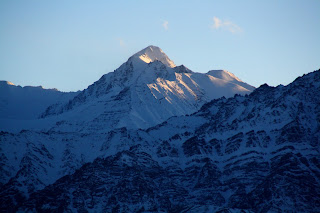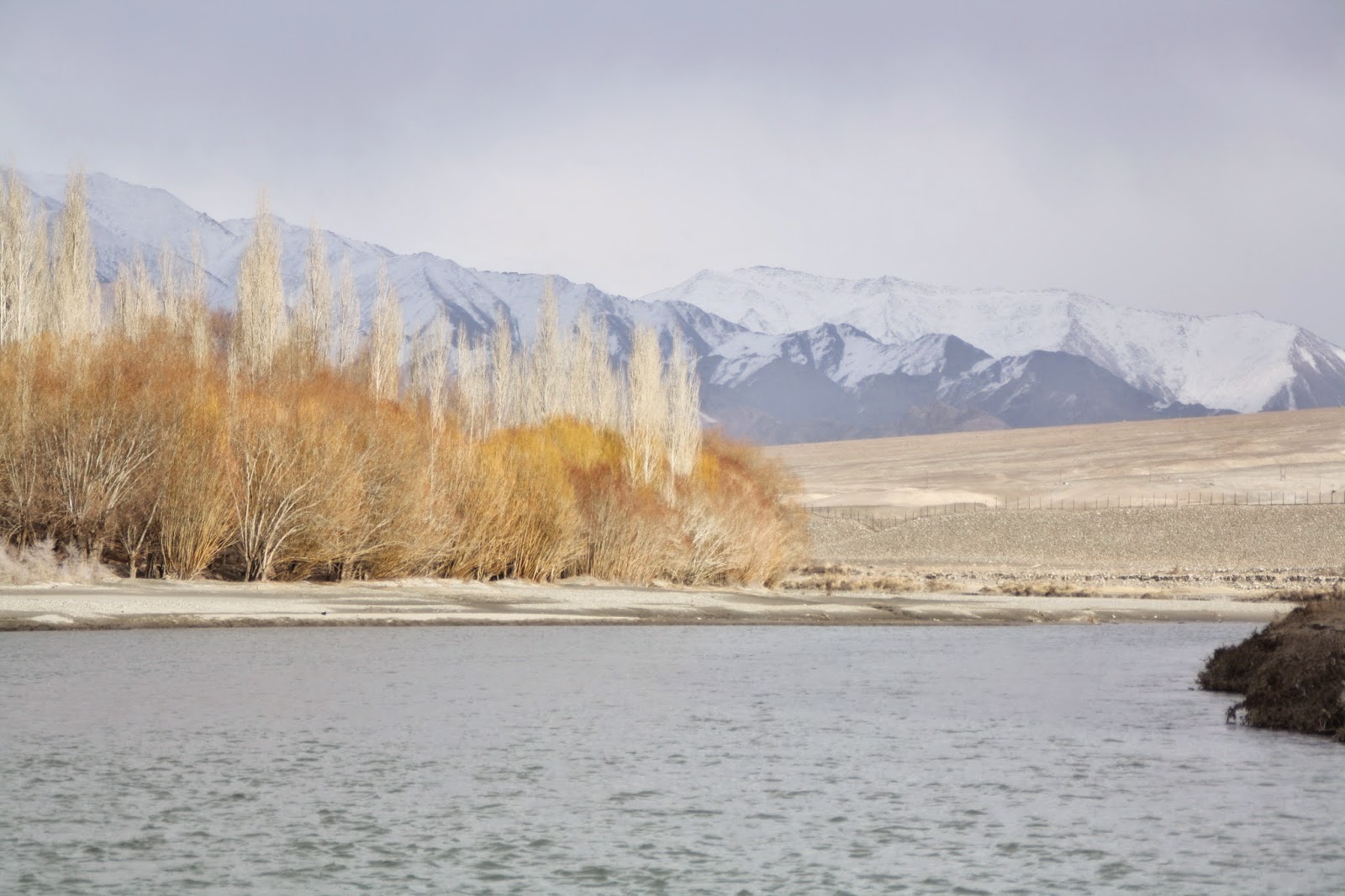 |
| Leh city |
1. Welcome to Leh
Stark brown massifs greet me as I wake with a start on my flight to Leh. For this wondrous sight alone, I decide to be politically incorrect and thank General Zorawar Singh, known as “little Napolean”, for leading the Dogra invasion and integrating this mountain-desert into the state of Jammu and Kashmir- an event often called an “accident of history”.
As the plane's wheels hit the tarmac, the Ladakhi woman next to me folds her hand in prayer as she comes home. She had been fussing over my clothes, suited to Bangalore winter low of 22 degree Celsius, but too porous for even Ladakh's “warm” weather. She asks me to put on more layers. When the plane settles and the pilot announces the temperature, she laughs with relief, “Oh it's okay! It is only minus 2!”
Leh, the entrance to Himalayan kingdom of Ladakh (“La-Tags”, Land of High passes), rests at 11,500 ft. It is also one of the shortest airplane descents you'll ever experience.
As Promit said when he landed a month later: “Planes don't land at Leh, they park at Leh”
2. And at the airport..
The tiny airport was teeming with Ladakhis. I was one of the few non-natives fumbling for my luggage. People greet each other with a sing-song “Ju-ley!”- a cheery all-purpose word used for hellos and thank yous. Security personnel stalk the perimetre of the airport, their exposed right hands charred black by the weather- an evidence of temperature and altitude. Stepping out, I become aware of entering a surreal world- a world in which the thin air cuts sharp, the altitude-induced wooziness sets in and mountains of impossible colours and bare poplar trees populate the Indus valley.
 |
| Indus Valley |
3. City
Leh, the central oasis in the high-altitude desert written along the Indus, was once a flourishing trade route of Central Asia. Traders, caravans from Yarkand, used to brave the mighty Khardung La pass, known as the world's highest motorable road that runs north of the city, to enter this hub of Silk Road en-route to Kashmir. Rising above the city, modelled after the Potala Palace in Lhasa, is the Leh Palace. Built by Sengge Namgyal in 17th century, the Palace was abandoned after the Dogra invasion, when the royal family, which had unified the Ladakh region, were exiled to Stok. The Dogras went on to capture Tibet but the harsh weather at the roof of the world killed and maimed thousands of troops. General Zorawar Singh also met his end.
 |
| Tsemo monastery |
From the Palace, you see Tsemo monastery, built by the staunchly Buddhist king Tashi Namgyal in 1430, sitting on the hilltop. I dragged myself up the steep hill like an ambitious turtle only to discover, to my amusement, a road snaking up to the gompa from the main city. But as I take in the distant wall of the Zanskar ranges, mud houses of the Old city, and the fluttering of prayer flags, the view feels earned- even if the monastery was closed.
 |
| The bazaar |
I climbed down to the bazaar to pack dinner before 4 pm- the closing time for most shops in winter, the off-season. The bazaar is lined with restaurants and stores selling rare turquoise from Changthang plateau, delicious dried apricots, Buddhist paraphernalia, and army surplus. Monks and military men mill about, women with head-scarves sell woollen clothes or tubers, and shrewd Kashmiri salesmen try to hard-sell the famous pashmina shawls while calling the firangs “gullible goats” under their breath.
It was disconcerting to enter a restaurant to see a Bollywood movie playing on the TV; the presence of our outside world in this strange, hypnotic place put me out of step. Ordering food becomes a negotiation during winter as the restaurants that are open are heavily dependent on supplies brought in by the Army. Expired cartons of juice sit unapologetically on store shelves.
Once the Chinese closed the borders to Tibet and Pakistan acquired control of Gilgit-Baltistan- Ladakh's independence, it's position as a caravan's pitstop on the legendary Silk Route was compromised. It isn't difficult to imagine these white washed mud houses once resounded with the gossip of traders and travellers, their tales of traversing the famous route, the bandits they encountered.
Ladakh was also the last frontier of Buddhism the waves of Islam from Central Asia beat against. Predominantly Buddhist, the region has a large number of Shia Muslims living in relative harmony. All restaurants observe dry days- a time when no meat will be served- on three auspicious days of the Buddhist calendar.
4. Villages
The landscape is dotted with monasteries overlooking each village like a spiritual guardian. The monastery and the village often share the name. During my period of volunteering as a teacher in a school, I heard cheerful stories from children about how their brother became a monk. One of the kids escaped monkhood because his grandfather, who was carrying him to the Lama (high priest), was much slower than his father, who was carrying his brother. I ask whether monks can renounce monkhood and a staff at the school says: “They can, but there is a derogatory word for those who do it.”
The villages here are one of the most self sufficient societies you'll see. Nothing here goes to waste-a lesson, with oncoming climate change, we must learn. Food that cant be eaten goes to the animals, the houses made of rammed earth and wood perch precariously on mountain slopes so as to not waste arable land and the human waste is used as compost. Armed with toilet paper, I was prepared for my first experience with Ladakhi dry compost toilet-a long drop where you shovel earth, ash, dry leaves on top of your waste. Most toilets have boxes of newspaper sheets helpfully cut out for you. I found it funny that the pandemonium that surrounds a newspaper production comes to this-a wrapper for vada pav, or in a toilet in Ladakh to use as substitute for toilet paper.
 |
| The Shanti Stupa |
5. Shanti Stupa
My hostel was close to the “must see” Shanti Stupa, which left me less impressed. Constructed as part of the Peace Pagoda mission by the Japanese and inaugurated by the Dalai Lama in 1991, the stupa seems alien, pristine, with murals of the four stages of Buddha's life, without any of the weathered character of the region. Then I saw the panorama of the Indus valley, an ant-line of army trucks going up on a distant mountain towards Khardung La and the magnificent Stok Kangri as the setting sun played with the colours of snow-peaked brown mountains. Magic. It wasn't difficult to imagine why “Maryul” (red land) was Ladakh’s ancient name.
 |
| Stok Kangri |
As the darkness begins to set in, the Shanti Stupa is lit up against the clear night sky and the speakers play the chant of Om Mani Padme Hum -“Hail the jewel in the lotus”. I was filled with reverence for the place which resists definitions because they cannot truly capture the beauty, the timelessness and the stillness that seeps into your very being. The caravans may have stopped coming, but the lure of Ladakh remains.
 |
| Lights out |


